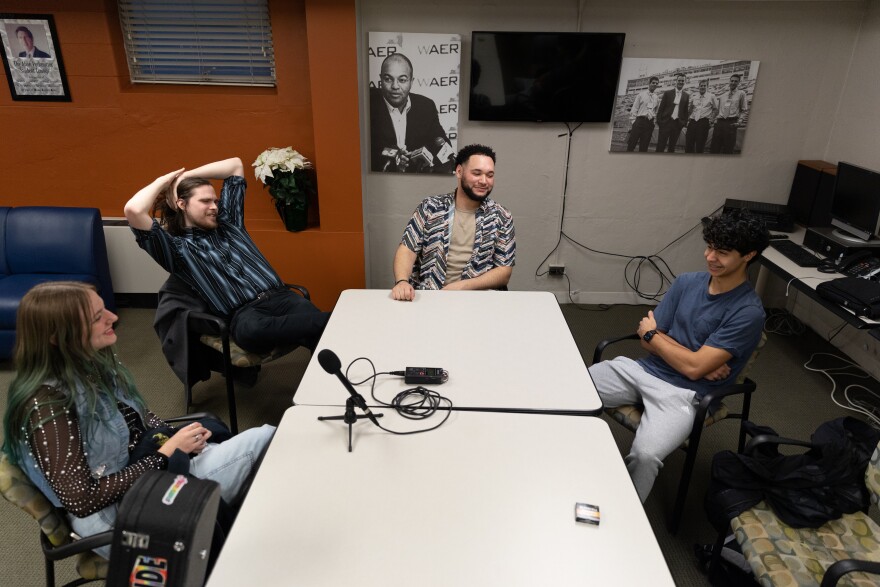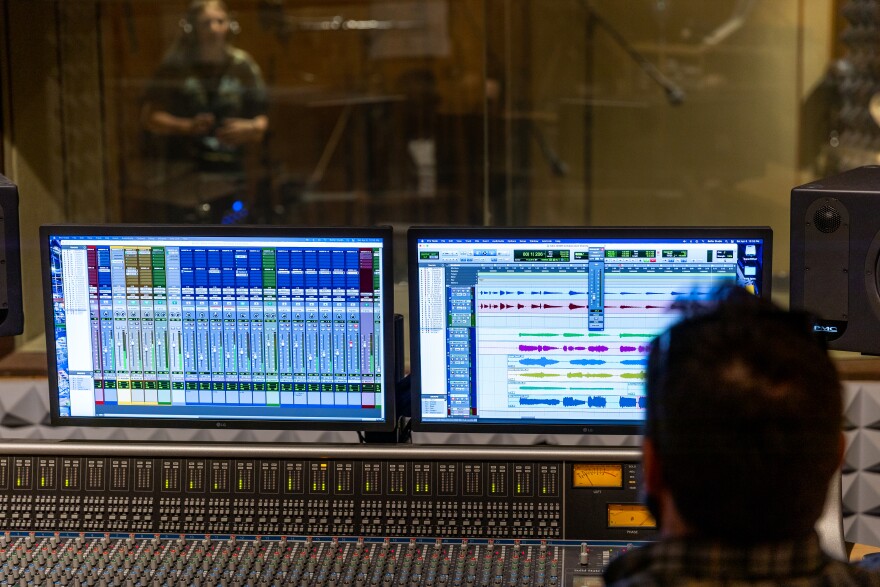For this inaugural session, five musicians — across different generations and genres — came together over the course of three weeks. The collaboration features two high schoolers and two working musicians in their early 20s, all collaborating under the guidance of Syracuse music scene veteran Joe Driscoll.
SPOTTING TALENT
“I think that there's something magical when musicians who haven't played together interact,” said Joe, who has created spontaneous songs, multiple times, with newly met musicians, in various countries.
To locate up-and-coming talent, WAER sought nominations and were connected with PSLA Fowler rising sophomore Mira Grimm, 15, and recent Manlius Pebble Hill graduate Ayman El-Hindi, 18.
Born into a musical family, Mira has played guitar and ukulele since age 11. It was over the course of COVID that she started to write her own songs, at age 12.
“I was in a love-hate relationship with music at that time,” she said. “I hit a point in my learning where I was ready to give up. I was like, 'I can't do this.' But if it's annoying me that much, I could just stop learning covers and write my own stuff. … write about how I feel.”

Now she’s working to complete her first album and can be spotted performing live at various spots, including center stage at the recent New York State Blues Festival.
All the musicians, including Marcus Oliver on drums and Cooper Francis on guitar, first met at the end of March at the WAER station, curious about what they’d just gotten themselves into.

On the night of that first meeting, Joe said “[Having this] kind of timeframe, where it's like all of a sudden you got a deadline. You're like, ‘OK, we got to pull something new [together] by Saturday.’ It's cool. “It's freeing in a way.”
MIRA’S MELODY
As that introductory meeting wrapped, Mira sat down at the table and started to strum two tunes she had in the works. “I’ve also got this … which is in A minor,” she said as she started to play her second tune … the riff that would become the basis for their original song.
Before leaving, a group chat was created so ideas and musical clips could be shared throughout the next week, preparing them for their first studio session held the first Saturday in April.
TOWN & GOWN
To produce the song, WAER partnered with Syracuse University’s Setnor School of Music, connecting with Jim Elenteny, who teaches sound recording technology. Jim was eager to be involved for the opportunity to have his students work directly with local musicians.
“For them, I think they were able to reinforce all of the concepts, lessons in class and actually see it in a real-world application,” the SU professor said.

Recording took place at the Belfer Audio Laboratory on campus, tucked away beside SU's Bird Library. It’s the first studio ever designed solely for audio preservation and utilizes the design concept known as LEDE -- Live End Dead End. For this, the area around the monitors is deadened, or made absorbent acoustically, and the remainder of the room (the part behind the listener) is made “live” or reflective.
“The room itself acoustically is extremely well designed,” Jim explained. “It was designed by a renowned acoustician named Chips Davis, who has made studios throughout the world. It's got great character. In the recording process, we're often concerned about the ambient sound reflections of the room, and that room is very, very, very well designed.”
FIRST SESSION
During the first studio session, as three of Jim’s students -- Eric Timlin, Eleanor Bushway and Taylor Fryer -- set up equipment, Mira noodles with the chord change. “So it would be ‘dah na naah na nuh na nuuh,’ Mira sings to Joe as she warms up on her guitar.

As the musicians continue to build off Mira’s original melody, she muses on what direction to take the song. “I really like the reggae feel,” she tells drummer Marcus. "Kick into the reggae feel with the brushes on the beginning … like very soft … with a jazzy feel and then the reggae.”
Joe likes all her suggestions and next pushes the group to find a tempo: “Good. Play through the progression with the brushes and then kick in with the groove. Now, let's try to find a BPM.”

Months later, reflecting on that session, Joe said, "Whenever you're in these situations, where everybody is improving, someone has to take a first leap. And Mira saying, ‘I got a couple chords,’ is always what you need. She's wicked young, and a bit of an introvert, but in that sense, she's like, ‘Yeah, we got to make this happen.’ She was willing to take the leap.”
RISING ARTISTS
Drummer Marcus grew up in a musical family, and says he earned his first paying gig as a teen after being spotted during a jazz band competition.

“After our set, one of the judges came backstage and was like, ‘Hey, man, you're killing it. I need a drummer for the Stan Colella All-Stars Band,’” Marcus recalled. “A lot of my peers from high school were in it, and I would ask them about it. They were like, ‘Man, you don't have what it takes. You can't make it.’”
It was Joe Carello, the band’s director at that time, who spotted Marcus during the competition.
“He comes up to me: ‘Hey man. You have what it takes,’” Marcus remembers him saying. Next, Marcus joined the pre-professional music program, which employed urban youth to perform each summer at community events. The initiative lasted 48 years, until being discontinued in 2018.
“For my first gig,” Marcus said, “I was happy.”
Now, he can be found performing with his band RÏsing Ghosts or at jam sessions held downtown.
For Cooper, rounding out the ensemble on guitar, he got his feet wet in music through school chorus, picking up guitar by high school. He studied music theory at the Crane School of Music at SUNY Potsdam and started taking his craft seriously about five years ago. He compares the process at hand to perfecting a meal.

“I feel like it's very difficult for a music-to-food metaphor to fall apart,” said Cooper while in the studio. “I feel like it's a very good one-to-one. Like, we're cooking.”
“We are cooking right now.”
STACKING LAYERS
“One of the biggest challenges in studio,” Joe began during an interview to reflect on the process “… you'll always hear people who have been working on albums for like eight years. They call it ‘analysis paralysis,’ when you have just so many options." He says musicians will ask themselves, "‘Is that the perfect snare? Is that the best pattern? Maybe we'll try it with this?’ And what I love about projects like this is, you realize that you don't have the choice.”
After the first day in studio, the musicians gathered for a late lunch to discuss their first session and what comes next.
“To recap, today was great. We didn't really know what we were getting into,” said Marcus, as he finished a dumpling at Taste of Asia on Marshall Street. “We had Mira’s little riff, and that definitely inspired some ideas for me. All we got to do now is get the lyrics in there, then shape the song a little bit more.”

The song’s foundation was built around that initial melody Mira played on the first night, then grew, layer by layer.
For Ayman, a recent Manlius Pebble Hill graduate who mostly observed during the first session, he clearly showed he absorbed every note. He walked around the studio, his head bopping to the beat while he emitted a faint whistle along to the chorus.
The second and final in-studio session focused on adding vocals, with the very last recorded track being Ayman’s whistle. It built-on a haunting texture to the song, and if the cooking metaphor holds, his contribution served as the cherry on top.
Ayman says his passion for music didn’t arrive until recently, the spark coming after joining his high school musical.

“I enjoyed the acting part of it, but mostly, I enjoyed the music part of it, and singing,” Ayman said. “Then from that, I started wanting to make my own songs.”
His newfound passion carried through his remaining year at the area private school, where students complete a senior capstone to graduate. For this independent project, Ayman challenged himself to write a musical, using Ableton, a digital software that allows him to compose, record and arrange songs using nearly any instrumentation he can imagine.
“I was obsessed with just coming up with all these little tunes,” he said. “That's really when I started taking my own initiative to learn how to make music.”
FINAL MIXDOWN
The group came together over Zoom by the start of the summer to reflect on the process and hear their final song.
After cheers and accolades, Joe says the song is “a banger,” noting Ayman’s whistle as “signature.”
Ayman sums up the song in one word, saying its whole atmosphere felt “smoky.”
Upon listening back to highlights from the in-studio sessions, Joe recalls little of the back-and-forth among musicians. “I don't have a clear memory of all that happened to make it what it was,” he said. “You listen to the track, and it just seemed like it lifted itself organically … but listening back, it's really cool to hear the play-by-play as everyone was making different decisions.”
As an aspiring session musician, Cooper says he enjoyed the experience. "It’s really cool to go into the studio and not know anything,” he said. “To be able to roll with the punches and complement what's already there.”
Speaking from experience, Joe says harmony among musicians is never a guarantee. “What’s really fascinating is how much it was a real collaborative production,” Joe concluded. “While there were a lot of chefs in the kitchen, it still worked amicably and turned out.”
Special Thanks for assistance to Kevin Kloss, James Abbott and Chris Bolt
Interested in being featured in the next Mashup? Click Here







